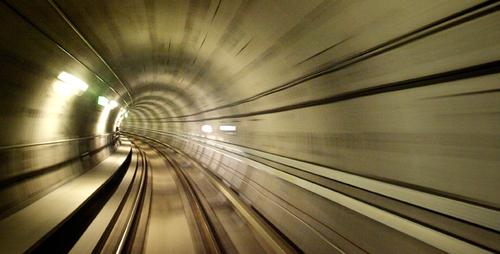Heating energy from a tunnel

No potential source of heating energy should be left unused if the German energy turnaround is to be successful. A promising pilot project has been realised in Jenbach, Austria: ground source energy from a railway tunnel is used to heat buildings.
The fact that the tunnel surface areas adjacent to soil or rock are large, means that tunnel structures can supply a considerable amount of geothermal energy. Even the tunnel air can make a significant contribution to energy generation. Recognition of this energetic potential has resulted in increasing efforts to utilise it.
Thermal utilisation of the areas
The tunnel walls are usually made of concrete, allowing thermal activation of the walls by insertion of absorber pipes and utilisation for heat exchange. This is achieved by integration of pipelines in the fresh concrete. A heat transfer medium flowing through the pipelines later makes it possible, for example, to remove heat from the structure in winter and use it for local heating, and to direct waste heat to the cooler tunnel structure in summer. Tunnel constructions that tend to get overheated (such as underground railway tunnels) can moreover be cooled by temperature control of the construction.
Thermal utilisation of the areas
The tunnel walls are usually made of concrete, allowing thermal activation of the walls by insertion of absorber pipes and utilisation for heat exchange. This is achieved by integration of pipelines in the fresh concrete. A heat transfer medium flowing through the pipelines later makes it possible, for example, to remove heat from the structure in winter and use it for local heating, and to direct waste heat to the cooler tunnel structure in summer. Tunnel constructions that tend to get overheated (such as underground railway tunnels) can moreover be cooled by temperature control of the construction.
Pilot project in the Jenbach Tunnel
In order to make the best possible use of thermal energy in the case of TBM (Tunnel Boring Machine) tunnels, an 'energy lining segment' has been developed by the engineering firm Arup in conjunction with Rehau AG and the tunnel construction specialist Züblin AG. Energy lining segments are precast concrete parts, which together form the tunnel shell. A special pipework system made of high pressure cross-linked polyethylene (PE-Xa), developed by Rehau is placed inside the energy lining segments. This allows the segments to remove heat from the immediate vicinity or to deliver heat to the construction. According to the manufacturer, the material is resistant to nicks, scratching and point loads, and is also reliable when bending radii are small. The lining segments are finally joined up to form a circuit and connected to a heat pump.
After extensive lab and field tests on the energy lining segments, the segments were for the first time fitted in a railway tunnel with the purpose of supplying a building with heat in Jenbach. This involved equipping a 54-metre section of the tunnel with energy lining segments. The integrated absorber pipes emerge at the surface via an emergency shaft. There they are connected to a heat pump, which supplies the municipal building yard of Jenbach with thermal energy. This project is the first geothermal power generation system integrated in a TBM tunnel. Similar projects have also been completed successfully in Germany, such as the extension of a city railway section of the U6 line in Stuttgart and the Katzenbergtunnel.
In order to make the best possible use of thermal energy in the case of TBM (Tunnel Boring Machine) tunnels, an 'energy lining segment' has been developed by the engineering firm Arup in conjunction with Rehau AG and the tunnel construction specialist Züblin AG. Energy lining segments are precast concrete parts, which together form the tunnel shell. A special pipework system made of high pressure cross-linked polyethylene (PE-Xa), developed by Rehau is placed inside the energy lining segments. This allows the segments to remove heat from the immediate vicinity or to deliver heat to the construction. According to the manufacturer, the material is resistant to nicks, scratching and point loads, and is also reliable when bending radii are small. The lining segments are finally joined up to form a circuit and connected to a heat pump.
After extensive lab and field tests on the energy lining segments, the segments were for the first time fitted in a railway tunnel with the purpose of supplying a building with heat in Jenbach. This involved equipping a 54-metre section of the tunnel with energy lining segments. The integrated absorber pipes emerge at the surface via an emergency shaft. There they are connected to a heat pump, which supplies the municipal building yard of Jenbach with thermal energy. This project is the first geothermal power generation system integrated in a TBM tunnel. Similar projects have also been completed successfully in Germany, such as the extension of a city railway section of the U6 line in Stuttgart and the Katzenbergtunnel.
